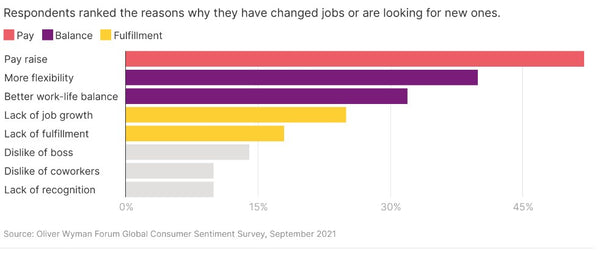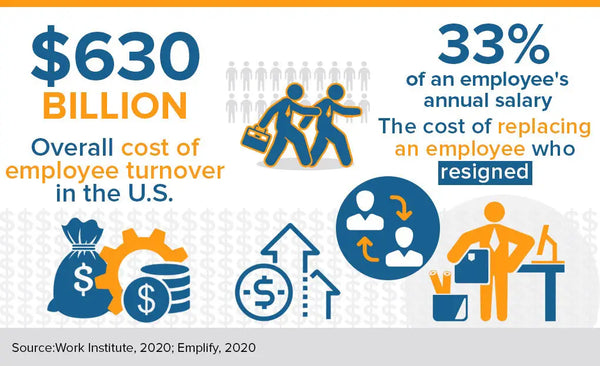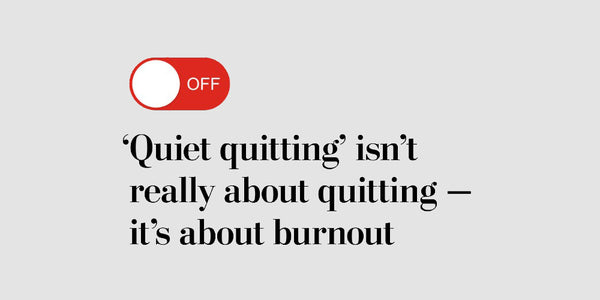My dad was an engineer in the 80’s and 90’s, in the gold mining region of South Africa, which at the time, was producing almost two thirds of the world’s gold.
He would drop us at school at 7.45am on his way to start work promptly at 8am, Monday through Friday. He’d be home by 4:30pm every afternoon, giving him time to tend to his vegetable garden and collection of cactus’ and succulents. I would spend hours with my dad in his garden, watching him do what he loved.
My dad was a "quiet quitting" Baby Boomer
He was a model employee who always arrived at and left work exactly on time, almost never called in sick and was well respected by all his colleagues. He worked for the same company for all the 18 years that I lived at home and he retired with lifelong health insurance coverage for him and my mom, a fully paid mortgage and a guaranteed pension that could comfortably support them both throughout the remaining years of their lives.

Besides carrying his brown leather briefcase (attache case) of notes, I never ever saw him doing work outside of the office. He worked hard at his job and enjoyed every minute of his time away from work. He had the perfect work life balance.
Changing times
I started my working career a few years before the dotcom bubble burst in 2001. As organizations dealt with the sudden crash in equity value, they were also replacing pension plans with 401(k) plans so that they were no longer responsible for paying their retired employees. I worked in Human Resources and had the wonderful opportunity of informing the workforce that support during our pension years was no longer guaranteed.
In 2008/09 the global financial crisis saw millions of Americans lose their homes to mortgage foreclosures, and by the summer of 2010 the jobless rate had risen to almost ten per cent.
And then in 2020 COVID made the past 20 years look like a dream vacation. Tens of millions of people lost their jobs and subsequently any health insurance benefits they may have had through their employers. In data collected from the Household Pulse Survey, nearly 20 million adults (9 percent of all adults in the country) reported that their household sometimes or often didn’t have enough to eat.
U.S. GDP fell by 8.9 percent in the second quarter of 2020, the largest single-quarter drop in more than 70 years. And many of us lived through the trauma of covid stricken households and even sudden deaths of multiple loved ones.

Work carries on
But work still goes on and companies need employees to continue to perform at their best and most effective, regardless of what’s happening in their lives or even the world.
Eventually, all this ongoing insecurity has led all of us to question how and where we spend our time and energy.
And thus, an unplanned-for consequence of the pandemic emerged. Dubbed the "Great Resignation", employees started leaving their jobs in droves. As employers scrambled to fill open positions, the voluntary quit rate was 25 percent higher than pre-pandemic levels.
A Pew Research Center survey found that low pay, a lack of opportunities for advancement and feeling disrespected at work were the top reasons why Americans quit their jobs last year.
Employees were also resigning in search of a healthier company culture and better work-life balance.

Employee loyalty is declining
Employees are clearly feeling disconnected from their work. Among the reasons for this: the multiple recessions, during which companies laid off huge swaths of their employees; a lack of benefits, training and promotion opportunities for those who remain; and a generation of young employees (ages 20 to 35) who have a different set of expectations about their careers, including the need to have control over their work life balance and job location.
"I do believe that culture [and] trust is part of the employee value proposition and that one must not discount some of the softer issues in the employment relationship because they are very highly valued by employees, specifically, given the fact that most of them would've been exposed to a lot of trauma over the last two years," says René Richter, MD of Remchannel, a cutting-edge reward management platform.
The cost of replacing an employee can be anywhere from 50% to 200% of their annual salary. Recruitment cost for a job position paying $80,000 can equate to over $150,000. Multiply that by the average number of employee resignations in one year and that cost can easily break the bottom line.

"Of those costs, I would say 30 percent to 40 percent are hard costs, and the other 60 percent are soft costs," said Edie Goldberg, founder of the Menlo Park, Calif.-based talent management and development company E.L. Goldberg & Associates.
Soft costs include the time departmental leaders and managers invest in supporting the HR-specific roles of the hiring process. When these are added to the hard costs, the price of recruiting skyrockets.
And then there’s Quiet Quitting.
Although a new term for an old concept (Employee Disengagement), "Quiet Quitting" is taking the workforce by storm.
The term is a bit of a misnomer, because quiet quitters aren't actually resigning. Instead they're quitting "the idea of going above and beyond at work," as TikTok user zaidleppelin said in a July post that has amassed more than 3 million views and helped popularize the phrase.
The trend is resonating strongly with those Gen Z and Millennial knowledge workers who are already burnt out after 20 years of hustling to get to the top, or even just survive in the workplace, and are now fighting to rewrite the rules of the workplace and re-evaluating how work should fit into their lives.

But what is Quiet Quitting you ask?
Quiet quitting is an act of "self-preservation," said Kacher, founder of Career/Life Alliance Services, at a time when employees feel like employers are asking workers to "do more with less."
"I think people are finally saying, 'You know what? I'm going to do less with less".
But this is something employers must navigate very carefully. Quiet quitting may equate to doing the bare minimum at work at one extreme or it may simply be a healthy recalibration of boundaries.
If you’re giving your best in the 40 hours you spend at work, and then want to spend the rest of the time doing something else that brings you joy, isn’t that a healthy balance? Isn’t quiet quitting simply doing what you're paid to do?
Employees are beginning to untangle their identities from their jobs and finding more time and energy to invest in other activities that bring them fulfillment in their lives.
As employers, we cannot hide our heads in the sand and hope this will disappear. We need to work to support our employees, to prevent a sudden decrease in productivity or "withdrawing” from the team, or cynicism or apathy" about work.
We need to act now before other colleagues start feeling frustrated about having to pick up the slack or start feeling shut out because their requests are not receiving the responses needed to do their own job.
Employees are looking for ways to feel more motivated and more engaged.
So how should employers respond?
What do companies do to retain engaged employees? Employers first need to recognize that quiet quitting is about more than just setting boundaries. The tired and frustrated feeling that many are experiencing lies on the tail end of the emotional, mental and financial rollercoaster of the past 20 years.
People are reassessing their priorities, and more carefully choosing how they spend their time. Right now employers have the choice to use the carrot or stick method to motivate the behavior they need.
OR, they can work to find a more long-term and effective solution that addresses the needs of their employees AND has positive side effects for the organization.

There are some basics of employee engagement that companies who care about their employees are, no doubt, already implementing.
- An engaging Onboarding Experience
- Autonomy and empowerment to fulfill their job functions
- Open communication channels
- Team building
- Learning Opportunities and Continued Education
- Regular opportunities for feedback
- A Formal Employee Wellness Program
But what seems to be missing is an understanding of the following: Showing support for the personal aspirations or acknowledging the self-doubts and fears of an employee can in fact also have several advantages to the organization.
Our lives consist of so much more than work and we are no longer simply being defined by our job titles and responsibilities.
It’s not that there’s a growing trend toward how things were in my Dad’s work days, where employees had a clear and distinct work-life balance. In fact, the push is way further beyond that. With the current technological advancements, employees now have the ability to stay clocked in for 24 hours a day and instead need to find a way to manage the blurry lines between work and life.

We can find fulfillment in all our roles, all at once.
We CAN fulfill all roles of career, family, personal life, etc. at the same time. We are all these things at the same time and don’t need to compartmentalize them. We learn that we can be a mother, a wife, have a career, and have a fulfilling personal life all at the same time. When they become all of who we are, we stop trying to build boundaries.
When organizations understand and support this merge between work and life, there is a beneficial side effect of improved productivity and emotional and social intelligence that comes with the intrinsic fulfillment of discovering your true self.
It's critical, now more than ever, that organizations show an understanding of the whole person.
Here at Dream Cast Project, we’re working with individuals and organizations to change mindsets and tap into human potential. We’re helping to seamlessly create positive habits that help you discover true potential, boost well-being and increase productivity, bridging the gap between where you are and where you want to be in life.
We are not advocating that employees work more than their allocated hours. Employees will naturally become more productive when they are intrinsically motivated, when there is balance in their lives, and when they feel organizations care.
How do we bridge this gap?
Our lives are wonderfully complex and our personal and professional lives intertwine on a daily basis. It's become really hard to separate home life with work life and we all know that the one directly affects the other.
We’ve created a product that bridges the gap to support employees in their personal and professional lives. Bridging this gap helps the individual build stronger relationships, they are happier at home and therefore at work too. They are more creative and have higher engagement. When employees bring that drive to work, they start to build stronger, more resilient teams. And from that personal growth, employees create a culture of high-performance across the entire organization.
Showing that your organization cares will have a direct positive impact for the organization. Companies with engaged employees grow profits up to three times faster than their competitors. Their employees have:
- Increased productivity and innovation
- High workplace morale
- Job satisfaction
- A positive atmosphere
- Good customer service
- Loyal and dedicated staff
At the Dream Cast Project this is how we address the challenges of the past 20 years in our work and home environments. It's such a simple solution that most will ignore and continue to use the carrot and stick method, continue competing on remuneration, and continue the unending loop of expensive employee recruitment and retention practices. However, for those that embrace it, well, the statistics speak for itself.
Find our more on how we can help your organizartion
Need more inspiration
If you are the type of person who finds it helpful to receive little reminders for building good habits, breaking bad ones, and inspiration to manifest your dream and goal... then follow us on Twitter, TikTok or Instagram









